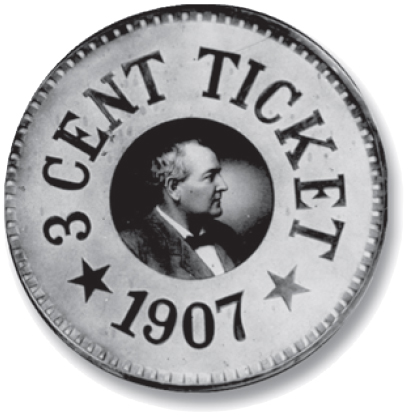Progressive Government: City and State.
Printed Page 567 Chapter Chronology

Progressive Government: City and State. Progressivism burst forth at every level of government in 1900, but nowhere more forcefully than in Cleveland with the election of Democrat Thomas Loftin Johnson as mayor. A self-made millionaire by age forty, Johnson moved to Cleveland in 1899, where he began his career in politics. During his mayoral campaign, he pledged to reduce the streetcar fare from five cents to three cents. His election touched off a seven-year war between Johnson and the streetcar moguls. To get his three-cent fare, Johnson had Cleveland buy the streetcar system, a tactic of municipal ownership progressives called "gas and water socialism." Reelected four times, Johnson fought for fair taxation and championed greater democracy through the use of the initiative and referendum to let voters introduce legislation, and the recall to get rid of elected officials and judges. Under Johnson's administration, Cleveland became, in the words of journalist Lincoln Steffens, the "best governed city in America."
In Wisconsin, Republican Robert M. La Follette converted to the progressive cause early in the 1900s. La Follette capitalized on the grassroots movement for reform to launch his long political career as governor (1901–1905) and U.S. senator (1906–1925). La Follette brought scientists and professors into his administration and used the university, just down the street from the statehouse in Madison, as a resource. As governor, La Follette lowered railroad rates, raised railroad taxes, improved education, preached conservation, established factory regulation and workers' compensation, instituted the first direct primary in the country, and inaugurated the first state income tax. Under his leadership, Wisconsin earned the title "laboratory of democracy." A fiery orator, "Fighting Bob" La Follette united his supporters around issues that transcended party loyalties. Democrats and Republicans like Tom Johnson and Robert La Follette crossed party lines to work for reform.
West of the Rockies, progressivism arrived somewhat later and found a champion in Republican Hiram Johnson of California, who served as governor from 1911 to 1917 and later as a U.S. senator. Since the 1870s, the Southern Pacific Railroad had dominated California. Johnson ran for governor in 1910 on the promise to "kick the Southern Pacific out of politics." With the support of the reform wing of the Republican Party and the promise "to return the government to the people," he handily won. As governor, he introduced the direct primary; supported the initiative, referendum, and recall; strengthened the state's railroad commission; supported conservation; and signed an employer's liability law.